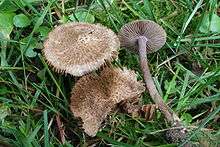Inocybe
| Inocybe (Fiber caps) | |
|---|---|
 | |
| Inocybe rimosa | |
| Scientific classification | |
| Kingdom: | Fungi |
| Division: | Basidiomycota |
| Class: | Agaricomycetes |
| Order: | Agaricales |
| Family: | Inocybaceae |
| Genus: | Inocybe (Fr.) Fr. (1863) |
| Type species | |
| Inocybe relicina (Fr.) Quél. (1888) | |
| Synonyms[1] | |
Inocybe is a large genus of mushroom-forming fungi. Members of Inocybe are mycorrhizal, and some evidence shows that the high degree of speciation in the genus is due to adaptation to different trees and perhaps even local environments.
Description

Typical mushrooms of the genus are any of various shades of brown, although some lilac or purplish species exist. Caps are small and conical, though flattening somewhat in age, generally with a pronounced raised central knob or umbo. The cap often appears fibrous or frayed, giving the genus its common name of "fiber caps". Many species have a distinctive odor, various described as musty or spermatic.
Classification
Originally placed in the family Cortinariaceae (later shown to be polyphyletic[2][3]), phylogenetic analyses suggests that the genus is better placed as the type genus of the family Inocybaceae.[4]
Toxicity
Inocybe species are not considered suitable for consumption, although in some underdeveloped countries certain species of Inocybe mushrooms are eaten. Many species contain large doses of muscarine, and no easy method of distinguishing them from potentially edible species exists. In fact, Inocybe is the most commonly encountered mushroom genus for which microscopic characteristics are the only means of certain identification to the species level. While the vast majority of Inocybes are toxic, seven rare species of Inocybe are hallucinogenic,[5] having been found to contain psilocybin, including Inocybe aeruginascens which also contains aeruginascine (N, N, N-trimethyl-4-phosphoryloxytryptamine).
Species
There are hundreds of species of Inocybe. Representatives of the genus include:
- Inocybe aeruginascens (psychoactive)
- Inocybe coelestium (psychoactive)
- Inocybe corydalina var. corydalina Quél. (psychoactive)
- Inocybe corydalina var. erinaceomorpha (psychoactive)
- Inocybe erubescens (= I. patouillardii) red-staining inocybe
- Inocybe geophylla (toxic)
- Inocybe haemacta (psychoactive)
- Inocybe hystrix

- Inocybe lacera
- Inocybe tricolor (psychoactive)
References
<div class="reflist columns references-column-width" style="-moz-column-width: refs
[1]; -webkit-column-width: refs
[1]; column-width: refs
[1]; list-style-type: decimal;">
- 1 2 3 4 "Synonymy: Inocybe (Fr.) Fr.". Species Fungorum. CAB International. Retrieved 2015-02-15.
- ↑ Moncalvo JM, Lutzoni FM, Rehner SA, Johnson J, Vilgalys R (June 2000). "Phylogenetic relationships of agaric fungi based on nuclear large subunit ribosomal DNA sequences". Syst. Biol. 49 (2): 278–305. doi:10.1093/sysbio/49.2.278. PMID 12118409.
- ↑ Moncalvo JM, Vilgalys R, Redhead SA, Johnson JE, James TY, Catherine Aime M, Hofstetter V, Verduin SJ, Larsson E, Baroni TJ, Greg Thorn R, Jacobsson S, Clémençon H, Miller OK (June 2002). "One hundred and seventeen clades of euagarics". Mol. Phylogenet. Evol. 23 (3): 357–400. doi:10.1016/S1055-7903(02)00027-1. PMID 12099793.
- ↑ Matheny PB (April 2005). "Improving phylogenetic inference of mushrooms with RPB1 and RPB2 nucleotide sequences (Inocybe; Agaricales)". Mol. Phylogenet. Evol. 35 (1): 1–20. doi:10.1016/j.ympev.2004.11.014. PMID 15737578.
- ↑ http://www.museocivico.rovereto.tn.it/UploadDocs/104_art09-Guzman%20&%20C.pdf
Further reading
- Atkinson, G. F. (1918). "Some new species of Inocybe". American Journal of Botany. 5 (4): 210–218. doi:10.2307/2435009. JSTOR 2435009.
- Cripps, C. L. (1997). "The genus Inocybe in Montana aspen stands". Mycologia. 89 (4): 670–688. doi:10.2307/3761005. JSTOR 3761005.
- Stuntz, D. E. (1978). Interim skeleton key to some common species of Inocybe in the Pacific Northwest. Notes and species descriptions by Gibson, I. (2004).